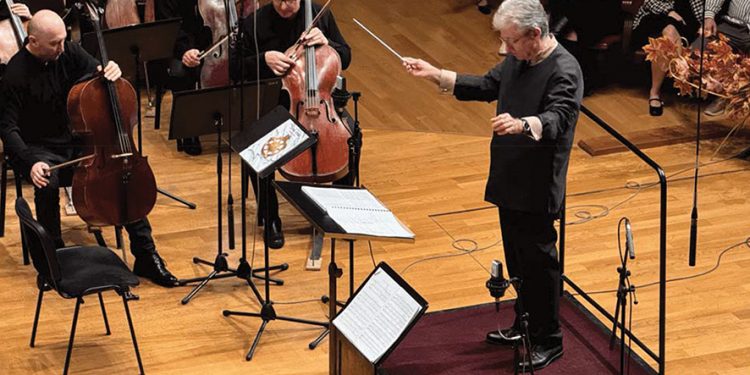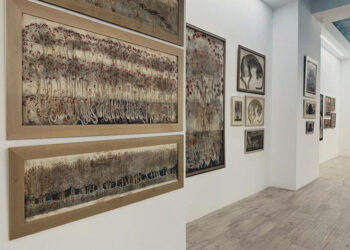The October 12, the performance of Carmina Burana at the Djansug Kakhdze Tbilisi Center for Music & Culture was more than just a concert—it was a convergence of musical forces, featuring the Tbilisi Symphony Orchestra, the Georgian State Choir, and the Choir of Batumi State Music Center, all under the expert baton of renowned Hungarian conductor Gábor Hollerung. This performance, part of the ‘Autumn Tbilisi’ International Music Festival, showcased Karl Orff’s masterpiece with a nuanced intensity that made for a night of musical grandeur and emotional complexity. Vocalists Sophie Gordeladze, Irakli Mujiri, and Mikheil Abramishvili provided captivating solo performances that added further depth to this already monumental work.
The Orff Phenomenon: A Ritual of Human Existence
Karl Orff’s Carmina Burana is a landmark in 20th-century choral-orchestral repertoire. First performed in 1937, it draws upon medieval Latin texts that meditate on fate, fortune, and the pleasures and perils of life. Orff structured the work as a scenic cantata, merging visceral rhythmic drive with lush harmonic textures. His use of repetition, pulsating rhythms, and declamatory vocal lines lends the work a sense of ritualistic grandeur, where the music’s raw power mirrors the primal themes within the text.
Gábor Hollerung: The Architect of Momentum and Precision
At the helm of this performance was conductor Gábor Hollerung, whose reputation as a specialist in large-scale choral and orchestral works has made him a sought-after conductor in the international music scene. Hollerung’s career spans decades, marked by a distinctive style that emphasizes structural clarity, rhythmic precision, and an unerring ability to sculpt vast musical landscapes. His background as both an orchestral conductor and a choral director imbues his approach with a deep understanding of how to integrate the vocal and instrumental forces in a seamless and organic manner.
One of Hollerung’s greatest strengths is his ability to maintain momentum without sacrificing nuance. Carmina Burana, with its relentless rhythmic underpinnings, requires a conductor capable of harnessing its energy while controlling the shifts in mood and tone. In this performance, Hollerung’s technique shone in his pacing—he allowed the music to build organically, never rushing through Orff’s powerful climaxes, but also never letting the energy dissipate during the quieter sections. This balance created a dynamic ebb and flow, keeping the audience on edge while allowing for moments of lyrical beauty to shine through.
His gestures on the podium were economical yet expressive, providing the performers with clear, unambiguous direction. Hollerung’s experience in navigating complex textures was evident in his treatment of the choirs and orchestra; under his baton, the rhythmic intricacies of Carmina Burana—from the opening, ominous strikes of “O Fortuna” to the boisterous energy of the drinking songs—were executed with precision. His attention to detail ensured that every section of the orchestra and choirs worked as part of a larger whole, yet still maintained their individual sonic identities.
Moreover, Hollerung’s understanding of choral timbre allowed him to highlight the choirs’ textual articulation without sacrificing the orchestral colors. In sections like “Veni, veni, venias,” where the rhythmic interplay between voices and instruments could easily become muddled, Hollerung maintained a crisp, driving tempo, allowing the text’s clarity and emotional intensity to ring out. His skillful balance of the vocal lines with the often thunderous orchestral accompaniment underscored his mastery of orchestral-choral integration, a hallmark of his conducting style.
The Georgian Choral Tradition: A Deep Well of Power
The choral forces—comprising the Georgian State Choir and the Choir of Batumi State Music Center—were another standout feature of the evening. Georgia has a rich choral tradition, and this was reflected in the choirs’ performance, which combined technical brilliance with emotional depth. Hollerung capitalized on this tradition, working with the choirs to produce a sound that was not only forceful and full-bodied but also flexible enough to handle the dynamic demands of Orff’s score.
In Carmina Burana, the choirs carry much of the emotional weight. Whether invoking the capriciousness of fortune in ‘O Fortuna’ or reveling in the raucous pleasures of spring and summer in ‘Veris leta facies,’ their role is to embody the very forces of nature and fate that the text so powerfully evokes. Hollerung, ever the architect, shaped their performance with precision, bringing out both the drama and the lyricism in their parts. The contrast between the biting articulation in the more rhythmic sections and the smooth, flowing lines in the lyrical passages demonstrated not just the choir’s skill, but also Hollerung’s ability to coax a wide emotional palette from them.
Soloists: Voices That Soar
Soprano Sophie Gordeladze, baritone Irakli Mujiri, and tenor Mikheil Abramishvili each delivered performances that added another layer of intensity to the concert. Gordeladze’s voice was particularly luminous in the sections that required lightness and clarity, such as ‘In trutina,’ where she effortlessly balanced the fragility and sensuality inherent in the music. Her voice floated above the orchestra, embodying the delicate tension between desire and restraint.
Mujiri’s baritone brought a dramatic heft to his roles, particularly in ‘Estuans interius,’ where the vocal line’s turbulent, restless quality was underscored by his dark, resonant tone. He captured the fire and frustration of Orff’s character, delivering a performance that was both passionate and finely controlled. Abramishvili, with his versatile tenor, lent an unexpected emotional depth to his parts, especially in the notoriously challenging ‘Olim lacus colueram,’ where the irony of the roasted swan’s lament was matched by Abramishvili’s deft navigation of the piece’s humor and pathos.
The Tbilisi Symphony Orchestra: A Landscape of Sound
Of course, no performance of Carmina Burana is complete without an orchestra capable of delivering both the raw power and the intricate details that Orff’s score demands. The Tbilisi Symphony Orchestra rose to this challenge with vigor and skill. Under Hollerung’s precise baton, the orchestra created a soundscape that was both overwhelming in its intensity and delicate in its attention to detail. The brass section, with its bold, declarative statements, laid the foundation for much of the work’s dramatic impact, while the strings provided the lush, often sensual undercurrent that gives Carmina Burana its sense of inevitability.
The percussion section was particularly crucial in maintaining the relentless rhythmic drive that propels much of the work. Hollerung’s ability to blend the sometimes overwhelming force of the percussion with the more subtle sections of the orchestra allowed for a cohesive performance, where every instrumental voice was part of a greater whole.
A Night of Power and Poignancy
In this performance, Gábor Hollerung and his assembled forces—soloists, choirs, and orchestra—brought Carmina Burana to life in a way that captured both its monumental scale and its intimate emotional core. The success of the evening lay in Hollerung’s ability to maintain a balance between these two poles, creating a performance that was both overwhelming in its power and deeply personal in its emotional resonance.
For the audience at the Djansug Kakhdze Tbilisi Center for Music & Culture, this concert was not just a display of musical virtuosity, but an exploration of the timeless themes of fate, fortune, and human passion that Carmina Burana so powerfully evokes. Through Hollerung’s clear-eyed vision and the performers’ extraordinary execution, this was a night where music transcended its form, becoming a communal experience that spoke to the very core of human existence.
Review by Ivan Nechaev














